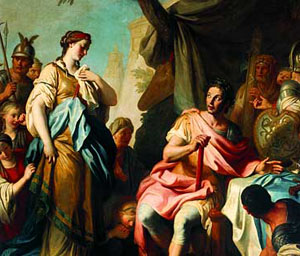02.16.2007 18:02
 By Andrei Vorobei
By Andrei Vorobei
Special to The St. Petersburg Times
The State Hermitage Museum premiered its major blockbuster of this season, “Alexander the Great: The Road to the Orient,” on Tuesday.
About 500 exhibits — paintings, prints, sculpture and applied art objects — from all the museum’s departments, showcases the ancient hero’s legendary campaign to Asia which resulted in an empire that spanned from the Balkans to India.
In many respects, this campaign, sometimes taken as the first example of cultural globalization, became paradigmatic for relations between East and West, whether it was during the wars of thousands years ago or the recent war in Iraq, when democratic values and personal freedom were delivered by the sword.
The restless personal biography of the Macedonian king Alexander III, (356 BC–323 BC) has become an integral part of the grand sweep of ancient history. Aged 20, Alexander took the Macedonian throne, by 26 had conquered the world (at least as the Greeks knew it), had prententions toward being a god, but died of a fever at the age of 33.
Aristotle was his tutor for some years and it was he who introduced the blond teenager to the work of Homer, the poet whose writings fascinated Alexander; in general, the Trojan War hero Achilles is mentioned as his forebear. Alexander inherited a superb army from his father, King Philip. Abrilliantly coordinated fighting machine, using cutting-edge engineering devices and managed by Alexander’s tactical genius, the army reduced to nothing larger, better, equipped enemies, bringing the young king only victories. The ambitious military genius made sure that his heroic deeds were recorded; dozens works about him were written by his contemporaries, but the main biographies appeared only centuries later, including those by Plutarch and Curtius among others.
The Hermitage exhibition consists of iconographical and archaeological parts housed in the incapacious Anteroom and the vast Nicholas halls respectively, and the whole show is beneficially framed by the classical interiors of Giacomo Quarenghi and Vasily Stasov.
Just as there is no authoritative biography, there are no original portraits of the great warrior.
However, three outstanding artists of the period — the sculptor Lysippos, the painter Apelles and the gemcutter Pyrgoteles — are traditionally mentioned as being responsible for the visual depiction of the character: a blond, handsome godlike youth with a leonine mane, severe look and a suit of armor.
As there have always been ambitious sovereigns — be it Louis XIV (there is a series of engravings referring to Charles Le Brun’s well-known painting cycle “The Battles of Alexander The Great” dedicated to the monarch), Catherine the Great (Richard Brompton’s painting visualizing the so-called “Greek Project” of the empress is on display as well) or Napoleon — there has always been a continual appeal to the ancient exemplar Alexander.
Highlighted by a quite standard collection of Alexander stories concerning Diogenes, the Gordian Knot, Apelles’s studio, Darius’ family and so on, the way he was depicted varies from the East to West, age to age, and spans refined Persian miniatures, pompous academician paintings and rough Russian lubok — cheap popular prints.
Surprisingly entertaining, the Anteroom’s display is followed by an authentic, scrappy reconstruction of Alexander’s route.
A selection of archaeological features of the period is by definition optional and fragmentary. Numerous rare mosaics, sculptures, amphorae, cameos, busts, manuscripts, coins, architectural details, painting fragments, murals and other cultural curiosities trace a process of Hellenisation across a gigantic territory from Europe, Egyptian Africa and Asia during and after Alexander’s time.
Scholars allocate two stages in Alexander’s campaign: the first is signified by unification of ancient Greek city-states and the liberation of the former Greek coastal regions of Asia Minor, while the period that followed after the invasion of Egypt and the establishment of Alexandria is characterised by greed and revenge as Alexander desired the defeat of every powerful empire of the time.
His maniacal pursuit of Darius III, the Persian king, was followed by the degradation and absorption of his empire, and ended up with a short-term invasion of India, a civilization that no westerner had yet imagined. If his contemporaries are to be believed, the deeper Alexander proceeded into Asia, the more intoxicated he became by it: the orientalisation of his clothes and manners turned him into kind of Oriental potentate.
But this, apparently, remains simply an interesting fact of his personal biography. Historically, the export of ancient Greek culture to beyond the the classical Greek region — from art, science, and literature to systems of the state management and urban ideas — is considered to the chief influence of that grandiose and bloody campaign.
“Alexander the Great” runs through May 1 at the State Hermitage Museum. Www.hermitage.ru
“Alexander the Great” runs through May 1 at the State Hermitage Museum. Www.hermitage.ru
News source: times.spb.ru
 Print this news Print this news
City news archive for 16 February' 2007.
City news archive for February' 2007.
City news archive for 2007 year.
|